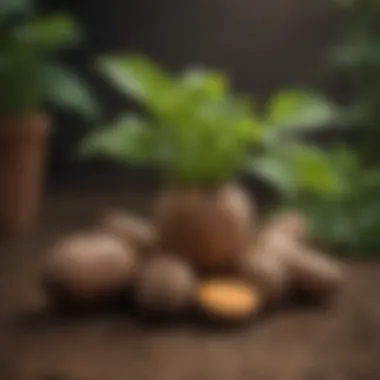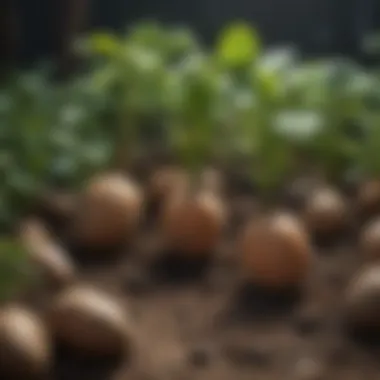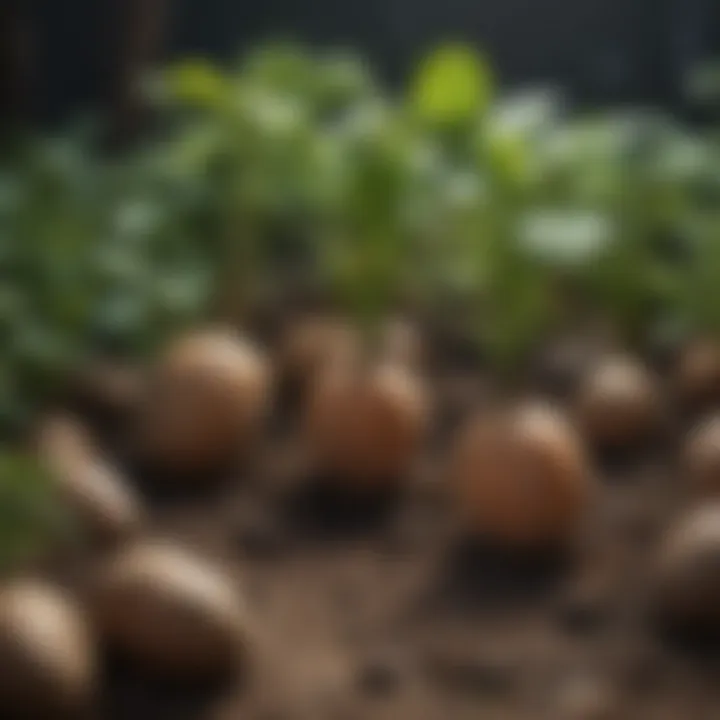Sweet Potato Companion Planting Guide for Success


Intro
Companion planting is an age-old gardening practice that emphasizes the strategic planting of different crops in proximity for mutual benefit. When it comes to sweet potatoes, the principles of companion planting can generate fruitful yields and limit pest issues. This guide explores how to effectively pair sweet potatoes with complementary plants, diving into their advantages and the underlying science. Understanding these relationships can be the difference between a garden thriving or dwindling.
Sweet potatoes, a nutrient-dense root vegetable, have specific needs when growing. They prefer well-drained soil, full sun exposure, and should not be tightly spaced. Knowing what plants work well alongside sweet potatoes can optimize their growth. In this text, we will discuss compatible plants, highlight potential pitfalls, and outline best practices for garden layout. Whether you are a novice or seasoned gardener, the insights provided here will be invaluable.
Benefits of Companion Planting
Companion planting offers several advantages that can enhance the gardening experience. The primary benefits include:
- Pest control: Some plants act as natural repellents to pests that might otherwise target sweet potatoes.
- Nutrient allocation: Certain plants can enhance soil fertility, providing sweet potatoes with necessary nutrients.
- Space efficiency: Utilizing space wisely with compatible plants can yield greater harvests without needing more land.
- Microclimate creation: Companion plants can help regulate moisture levels for sweet potatoes, improving their overall health.
"The right companions can elevate your gardening outcomes significantly."
Compatible Plants for Sweet Potatoes
In understanding companion planting, it is crucial to identify plants that thrive alongside sweet potatoes. Here are a few recommended companions:
- Beans: These legumes can fix nitrogen in the soil, which benefits sweet potatoes.
- Corn: Its tall stalks provide natural support for sweet potato vines and can create a shaded environment.
- Nasturtiums: This flowering plant can deter aphids, which pose threats to sweet potatoes.
- Marigolds: Known for repelling nematodes, marigolds can safeguard the health of the sweet potato roots.
Some plants, however, should be avoided in the same vicinity. For example, cabbages and other members of the brassica family can compete for nutrients and may attract pests, leading to stunted growth in sweet potatoes.
Garden Layout Considerations
Designing an effective garden layout is critical for companion planting. Here are a few essential points to remember:
- Space for Growth: Sweet potatoes require ample space. They should be spaced at least 12 to 14 inches apart.
- Layering: Taller plants like corn can be placed on the north side of the garden to avoid shading smaller crops.
- Intercropping: Use fast-growing plants like beans as fillers between slower-growing varieties such as sweet potatoes.
Choosing the right layout based on expected plant heights and growth habits can optimize your garden's productivity.
Environmental Considerations
Climate and soil type significantly affect the success of companion planting. Sweet potatoes prefer warm soil and should be planted after the last frost. Ensure your growing environment stabilizes moisture but avoids waterlogged conditions, which can lead to rot.
Understanding specific environmental factors plays a key role in ensuring healthy growth. This can include local pests that might impact your chosen companion plants.
Culmination
Implementing companion planting strategies with sweet potatoes can yield many rewards. By understanding which plants work harmoniously and considering garden layout, you can create an ecosystem that encourages healthy growth. Taking the time to learn and plan is the first step towards a bountiful harvest. Each detail, from climate to companion relationships, contributes to gardening success.
Prologue to Companion Planting
Companion planting is an agricultural technique that pairs different plants together for mutual benefits. This method can enhance crop yield, reduce pest problems, and improve soil health. As gardeners aim for greater sustainability and productivity, understanding companion planting is essential. The practice not only maximizes space in gardens but also creates a more diverse ecosystem.
Definition of Companion Planting
Companion planting entails strategically arranging plants so they can support each other in various ways. This can include enhancing growth, deterring pests, and improving nutrient uptake. For example, certain plants can provide shade or act as a natural repellent to insects that may harm the main crop. This symbiotic relationship leads to healthier plants and a more productive garden.
Historical Perspectives
Throughout history, companion planting has been used in various cultures. Indigenous peoples in North America utilized this technique with the "Three Sisters" method, consisting of corn, beans, and squash. Each plant plays a specific role: corn provides support, beans fix nitrogen in the soil, and squash spreads out to block weeds. Such historical practices validate the wisdom behind planting compatible crops together. Understanding these past techniques can inspire modern gardeners to utilize the same beneficial strategies in their own gardens.
Understanding Sweet Potatoes
Understanding sweet potatoes is essential for successful companion planting. These root vegetables, scientifically known as Ipomoea batatas, are not only nutritious but also play a vital role in ecological gardening practices. Knowledge of their growth habits, optimal conditions, and nutrient needs helps gardeners foster an environment where both sweet potatoes and their companion plants can thrive.
Botanical Characteristics
Sweet potatoes are a member of the morning glory family and are characterized by their sprawling vines and heart-shaped leaves. The plants can reach lengths of up to several feet, which means careful consideration must be given to their space requirements in the garden.
They are warm-season crops and prefer well-drained soil with good fertility. The roots can be orange, yellow, or even purple depending on the variety. Their adaptability enables them to thrive in diverse environments, yet they do require specific conditions of temperature and moisture for optimal growth. With deep roots, they help in soil aeration and moisture retention, aiding the growth of surrounding plants. This is one reason why understanding their botanical characteristics aids in effective companion planting.
Nutritional Benefits
Sweet potatoes are not just versatile in the kitchen; they are also rich in nutrients. They contain high levels of vitamins A and C, potassium, and dietary fiber. These nutritional benefits contribute to a balanced diet, making sweet potatoes a favored choice among health-conscious individuals.
Eating sweet potatoes can enhance immune function, support vision, and promote digestive health. By incorporating companion plants that can complement their nutritional profile, such as certain herbs and vegetables, the overall health of a garden increases.
Moreover, the presence of sweet potatoes can improve the soil microbiome. Their growth can lead to better nutrient availability for neighboring plants, creating a mutually beneficial ecosystem.


"A well-planned companion planting strategy can enhance both the yield of sweet potatoes and the health of your garden."
In summary, understanding sweet potatoes is a fundamental aspect of successful companion planting. Their unique botanical features, combined with nutritional benefits, make them an excellent choice for those looking to maximize their gardening efforts.
Benefits of Companion Planting
Companion planting is an established horticultural practice that offers numerous advantages to gardeners, especially those cultivating sweet potatoes. The benefits include natural pest control, enhanced soil quality, and efficient use of garden space. These elements not only improve the health and yield of plants but also promote a sustainable gardening approach.
Pest Control
Pest management is one of the most significant advantages of companion planting. By strategically pairing sweet potatoes with certain plants, gardeners can naturally deter pests. For example, planting marigolds alongside sweet potatoes can repel harmful insects such as nematodes and aphids.
These flowers emit compounds that are unattractive to various pests. Furthermore, some herbs, like basil, have the added benefit of attracting beneficial insects that prey on pests. Therefore, utilizing companion planting helps maintain a balanced ecosystem in the garden, reducing the reliance on chemical pesticides.
Soil Improvement
Soil health is crucial in any gardening endeavor, and companion planting serves as an excellent method for improving it. Plants such as clover can fix nitrogen in the soil, enriching it for sweet potatoes and promoting robust growth. This natural enrichment is pivotal, as sweet potatoes thrive in nutrient-rich environments.
Additionally, some plants can improve soil structure. For instance, deep-rooted plants can help aerate the soil, allowing water and nutrients to permeate more effectively. This results in healthier soil that supports diverse microbial life, essential for sustaining a flourishing garden ecosystem.
Maximizing Space and Yield
In urban gardening or small plots, maximizing space is critical. Companion planting allows gardeners to make better use of available land. Different plants can occupy the same space efficiently when grouped together appropriately. This practice ensures that each plant does not compete for essential resources like water and nutrients.
Moreover, specific plant combinations can yield higher overall production. For instance, growing sweet potatoes alongside beans can provide not only a complementary growing habit but also enhance yield. Beans fix nitrogen in the soil, further supporting sweet potato growth.
"Companion planting, when practiced correctly, transforms a garden into a more productive and resilient environment."
Choosing Compatible Plants for Sweet Potatoes
Selecting the right companions for sweet potatoes is crucial for achieving optimal growth and yield. Companion planting can enhance growth, deter pests, and improve soil structure. Understanding the specific needs and characteristics of sweet potatoes helps in choosing plants that can coexist harmoniously in the garden. Effective partnerships in planting can also lead to healthier plants and bountiful harvests, highlighting the functional aspect of biodiversity in gardening.
Herbs that Pair Well
Certain herbs are particularly beneficial when planted alongside sweet potatoes. Basil, for instance, not only enhances the flavor of nearby crops but also repels common pests such as aphids and beetles. Chamomile has been noted for its ability to strengthen the health of neighboring plants by attracting beneficial insects. Furthermore, oregano acts as a ground cover that can suppress weed growth while also providing a habitat for beneficial insects.
When integrating these herbs into your planting strategy, consider planting them in clusters around the sweet potatoes. This strategy maximizes the benefits of their growth and keeps competition for nutrients minimal. Additionally, the aromatic profiles of these herbs can confuse pests who may not be able to locate their target plants easily.
Vegetable Allies
In the realm of vegetables, certain varieties serve as excellent allies to sweet potatoes. Corn is an ideal companion; it provides vertical space and a natural trellis for sweet potato vines. The shade from corn can help keep the soil moist, which is important for sweet potatoes.
Bean varieties, notably pole beans, can also benefit sweet potatoes. They fix nitrogen in the soil, enhancing fertility, which is beneficial for nutrient-hungry crops like sweet potatoes. Meanwhile, radishes can grow quickly enough to compete with weeds, protecting the sweet potatoes during their early growth. Incorporating these vegetables requires careful planning to ensure adequate spacing and sunlight.
Flowering Companions
Flowering plants offer both aesthetic appeal and practical benefits when combined with sweet potatoes. Marigolds are a popular choice; their strong fragrance deters pests like nematodes and aphids. Additionally, nasturtiums attract various predatory insects that help control pest populations.
Planting flowers among sweet potatoes can also enhance pollination for nearby crops, increasing overall garden productivity. When choosing flowering companions, ensure they complement the growing conditions preferred by sweet potatoes, maximizing both beauty and utility in the garden.
The right choice of compatible plants can significantly impact the health and productivity of your sweet potato garden. Choosing wisely leads to a more sustainable and productive gardening experience.
Identifying Incompatible Plants
Identifying incompatible plants is a critical aspect of companion planting, especially when growing sweet potatoes. This practice is not merely about pairing compatible species but also about understanding which plants may hinder growth and yield. Plant incompatibilities can stem from a variety of factors, such as competition for nutrients, water, and light, as well as the release of allelopathic chemicals that can harm neighboring plants. Awareness of these factors allows gardeners to create a more harmonious growing environment, ultimately improving overall plant health.
Plants to Avoid
When choosing companion plants for sweet potatoes, several specific varieties should be avoided due to their negative interactions. These include:
- Potatoes: Growing sweet potatoes alongside regular potatoes can lead to both plants competing for similar nutrients. This competition may result in stunted growth and lower yields.
- Tomatoes: Tomatoes and sweet potatoes both belong to the nightshade family, which makes them prone to similar pests and diseases. Planting them together can increase the likelihood of issues like blight.
- Cabbage Family Members: Crops such as cabbage, broccoli, and kale can compete for nutrients and space. Their fast growth may overshadow and outcompete sweet potatoes.
- Eggplants: These are also nightshades and can lead to the same problems as tomatoes, sharing pests and diseases, and ultimately decreasing yield.
Recognizing these plants and avoiding their placement near sweet potatoes is essential for successful growth. Proper planning in the garden layout can increase the chances of a thriving companion planting setup.
Consequences of Poor Pairings
The consequences of poor plant pairings can significantly affect not only the growth of sweet potatoes but also the overall health of the garden. Here are some of the potential negative outcomes that can arise:
- Decreased Yield: When incompatible plants grow together, they often produce lesser yields. The competition for essential resources can impede growth for both species.
- Pest Infestations: Certain combinations can attract specific pests that are harmful to sweet potatoes. For example, pests attracted to tomatoes may also invade sweet potatoes, leading to increased damage.
- Nutrient Deficiencies: The presence of certain plants can lead to nutrient depletion. Incompatible plants may absorb essential nutrients quicker and leave sweet potatoes vulnerable to deficiencies.
- Disease Spread: Incompatibility often leads to higher risks of disease transmission. Close quarters with certain plants can increase the likelihood of pathogens spreading, affecting overall plant health.


Understanding the importance of correct plant pairings can be the difference between a flourishing garden and a disappointing harvest.
Environmental Factors in Companion Planting
Understanding the environmental factors in companion planting is critical for achieving optimal results, especially when cultivating sweet potatoes. These factors determine how plants interact and thrive in a shared environment. Proper attention to soil composition, light, and water requirements is necessary for successful cultivation. Not only do these elements affect growth rates, but they also influence the overall health and vitality of the plants. With the right environmental considerations, gardeners can create a thriving ecosystem in their gardens.
Soil Composition
Soil composition is the foundation of any successful garden, including those involving sweet potatoes. The right mix of sand, silt, clay, and organic matter in the soil creates an ideal environment for root development. Sweet potatoes prefer well-draining, loamy soils that allow their tubers to expand efficiently. Heavy clay or compacted soil can hinder their growth significantly, leading to smaller yields.
- Key Soil Constituents:
- Nitrogen: Essential for growth, nitrogen influences leaf development and health.
- Phosphorus: Supports root and tuber formation, particularly important for sweet potatoes.
- Potassium: Regulates water retention and photosynthesis, contributing to overall plant vigor.
Soil health should be assessed regularly. Adding organic matter like compost can enhance soil fertility and structure. Regular testing will provide insights on pH levels and nutrient availability, guiding amendments to optimize plant growth.
Light and Water Requirements
Light and water are also pivotal in companion planting for sweet potatoes. Sweet potatoes thrive in full sun, requiring at least six hours of direct sunlight each day. This exposure not only boosts their photosynthesis process but also strengthens the plant’s resilience against pests.
- Light Consideration:
- Full Sun Exposure: Essential for growth, less light leads to poor yields.
- Plant Arrangement: Taller companions provide shade, potentially limiting sweet potatoes' light intake.
Watering needs are another critical element to consider. While sweet potatoes are drought-resistant, consistent moisture during the growing season promotes healthy tuber formation. Overwatering, however, can lead to root rot.
- Water Management Tips:
- Maintain Soil Moisture: Use mulch to regulate soil temperature and moisture levels.
- Drip Irrigation: This method conserves water and delivers it effectively to root zones.
Proper attention to soil composition and moisture levels can significantly enhance the growth of sweet potatoes, making them more productive and resilient against environmental stressors.
In summary, focusing on these environmental factors enhances companion planting strategies. While considering soil composition, light, and water, gardeners will be better equipped to cultivate sweet potatoes successfully. By understanding and managing these factors, sweet potatoes can flourish alongside their companions, resulting in a more abundant harvest.
Best Practices for Planting
Planting sweet potatoes effectively is vital for their growth and overall health. By implementing best practices, gardeners ensure optimal conditions for their crops. Focusing on the layout and timing of the planting can significantly impact yield and health of the plants.
Garden Layout
An efficient garden layout is crucial for the successful cultivation of sweet potatoes. The placement of these plants in relation to companion plants influences not only space usage but also pest control and nutrient availability. Sweet potatoes thrive in loose, well-drained soil with adequate sunlight.
- Row Spacing: Maintain a distance of at least 3 feet between rows to allow the vines to spread. This spacing reduces competition for nutrients and provides air circulation, which is essential for preventing diseases.
- Companion Placement: Prioritize placing compatible plants nearby. For example, growing beans alongside sweet potatoes can help fix nitrogen in the soil, benefiting both plants. Consider the height and spread of companion plants to avoid shading sweet potato leaves, which may hinder their growth.
- Elevated Beds: Using raised beds can improve drainage and soil temperature, which favor sweet potato development. Ensure that the soil mix is rich in organic matter to provide a fertile base.
Timing and Seasonality
Understanding the timing of planting is equally important. Sweet potatoes require warm soil to flourish. Therefore, planting times must be aligned with local climate conditions. Here are some key points for timing sweet potato planting:
- Soil Temperature: Ideal soil temperature for planting sweet potatoes is around 65 to 75°F. Planting too early may expose tubers to cold soil, causing slow growth or rot.
- Frost Dates: Check local last frost dates before planting. Sweet potatoes are sensitive to frost; planting after the final frost allows the plants to establish well.
- Seasonal Growth: Sweet potatoes typically require a growing season of about 100 to 150 days before harvest. Plan out the planting schedule accordingly to maximize the length of the growing season.
"Efficient planning of garden layout and timing leads to healthier crops and improved yields."
In summary, adhering to best practices for planting includes a well-thought-out garden layout and strategically timed planting. By carefully considering these factors, gardeners can enhance the health and productivity of their sweet potato crops.
Common Issues and Solutions
Companion planting, especially with sweet potatoes, is not without its challenges. Understanding common issues that might arise can aid in preventing and resolving problems efficiently. This section will address two significant areas: pest infestations and nutrient deficiencies. Both problems can impact the overall health of your sweet potato plants, and knowing how to identify and manage these issues is essential for a successful garden.
Pest Infestations
Pest infestations present a primary challenge for gardeners growing sweet potatoes. Various insects can be attracted to sweet potato plants, including aphids, sweet potato weevils, and spider mites. These pests not only damage the foliage but can also interfere with the tuber development underground.
Monitoring and Prevention
- Regularly inspect plants for signs of pests. Look for discolored leaves or tiny bugs on the stems and leaves.
- Utilize traps or natural repellents to deter pests before they become a significant issue.
- Certain companion plants, such as marigolds and nasturtiums, can be planted nearby to help deter unwanted insects.
If pest infestations occur, consider using organic pesticides as a last resort. Products containing neem oil or insecticidal soaps can be effective in treating many pest issues while being less harmful to beneficial insects.
Nutrient Deficiencies


Nutrient deficiencies can have severe implications for sweet potato crops. A lack of essential nutrients like nitrogen, phosphorus, and potassium can lead to poor growth, smaller tubers, and reduced yield. Symptoms of nutrient deficiencies can vary, but common indicators include yellowing leaves, stunted growth, or poor flowering.
Identification and Correction
- Conduct soil tests to determine the nutrient content of your garden soil. Understanding soil composition will guide your fertilization strategy.
- Address deficiencies through the use of organic fertilizers. Options like compost or well-rotted manure can help replenish nutrients in the soil.
- Incorporate nitrogen-fixing plants, such as legumes, into your garden to improve soil fertility over time.
Epilogue
In summary, being aware of common issues and their corresponding solutions can enhance your sweet potato gardening experience. Regular monitoring, proactive measures, and adjustments based on soil health will lead to more robust plants and higher yields. Educating yourself about pests and nutrient needs will help in cultivating a thriving garden, ultimately benefiting your harvest.
A Case Study in Companion Planting
In exploring the realm of sweet potato companion planting, the significance of examining real-life examples cannot be overstated. Case studies provide invaluable insights into practical applications, showcasing both the successes and challenges faced by gardeners. Ultimately, these case studies serve as a practical guide, illustrating how companion planting can lead to improved yields and healthier plants.
Successful Garden Examples
One notable case comes from a community garden in Oregon. Gardeners there decided to combine sweet potatoes with beans and marigolds. Beans fix nitrogen in the soil, bolstering the nutrient profile. Marigolds have potent pest-repelling properties, which minimize the threat from harmful insects. Over the growing season, this combination not only led to a bountiful harvest of sweet potatoes but also promoted soil health and reduced pest issues. Gardener testimonials highlighted how these companions worked symbiotically, indicating enhanced growth.
Another garden, located in California, used a method involving sweet potatoes alongside squash and basil. Squash, with its expansive leaves, provided ground cover that helped retain moisture. Basil, on the other hand, is known to attract pollinators. Throughout the season, the garden managed to produce sweet potatoes with rich flavors, with many gardeners commenting on the benefits of having various plants in close proximity. They reported a vibrant ecosystem where both root and leaf crops thrived together.
Lessons Learned
From these case studies, several lessons can be drawn. First, it is essential to understand plant relationships. For instance, incorporating nitrogen-fixing plants can radically improve the soil’s nutrient availability. Moreover, selecting companions that deter pests can alleviate the need for chemical interventions, fostering a more organic gardening environment.
Additionally, one must pay attention to the specific needs of each plant species. Sweet potatoes need well-drained soil and full sun exposure. When planning companions, these requirements should guide your choices. Gardening enthusiasts found that sometimes, even popular companion plants could end up competing for resources. Therefore, careful observation and adjustments can lead to better outcomes.
Moreover, patience is vital. Observing the growth patterns and interactions over multiple seasons helps refine the combinations for maximum yield. Each garden is unique, and what works perfectly in one might not work in another. Gardening is about adaptation and learning over time.
"The key takeaway from case studies in companion planting is simple: understanding the intricate relationships between plants can yield remarkable results."
Sustainable Gardening Practices
Sustainable gardening practices are crucial for ensuring an eco-friendly approach to gardening. As climate change and environmental degradation continue to pose significant challenges, embracing sustainability allows us to cultivate sweet potatoes with minimal impact on our surroundings. This section will focus on two major components: organic approaches and permaculture principles.
Organic Approaches
Organic gardening emphasizes natural processes and materials. This method avoids synthetic fertilizers and pesticides, opting instead for compost, natural mulch, and organic amendments. The benefits of organic approaches are significant:
- Soil Health: Organic matter improves the soil's structure, nutrient content, and water retention, creating the ideal environment for sweet potato growth.
- Biodiversity: By encouraging a variety of plants and microorganisms, organic gardening fosters ecosystems that can suppress pests and diseases naturally.
- Reduced Chemical Exposure: This practice minimizes the risk of exposing the gardener, family, and local wildlife to harmful chemicals, promoting healthier living.
Implementing organic approaches does require planning. Gardeners should start with a soil test to identify existing nutrient levels and deficiencies. From this, they can amend the soil using compost, aged manure, or other organic matter prior to planting.
Permaculture Principles
Permaculture is not just about gardening; it represents a holistic design philosophy that mimics natural ecosystems. When applying permaculture principles to sweet potato gardening, several key aspects come into play:
- Design Integration: Permaculture encourages designs that maximize energy efficiency and minimize waste, such as companion planting and creating swales to manage water.
- Fostering Resilience: Diverse planting strategies protect crops from pests and diseases, creating a more resilient garden that adapts to environmental stresses.
- Sustainable Resource Management: This principle includes rainwater harvesting and utilizing kitchen scraps as fertilizer, reducing the reliance on external inputs.
> "Permaculture promotes harmony between nature and gardening, aligning agricultural practices with ecological stewardship."
Permaculture principles can transform a garden into a harmonious space that requires less maintenance over time. Using methods such as cyclic planting and perennial cropping can lead to increased yields and soil fertility, fostering an environment that flourishes on its own.
These sustainable practices serve as tools for gardeners to enhance their sweet potato yield while simultaneously caring for the planet. By integrating organic approaches with permaculture principles, homeowners can engage in responsible gardening that respects environmental boundaries.
The Future of Companion Planting
As the world increasingly embraces sustainable practices, the future of companion planting emerges as a significant aspect of modern gardening. With growing concerns about food security, environmental sustainability, and ecological balance, gardeners are looking for methods that not only enhance their yields but also promote biodiversity. Companion planting offers numerous advantages that align perfectly with these emerging priorities.
Trends in Gardening
The trends shaping the future of gardening reflect a profound shift towards ecological approaches. Among these, companion planting plays a vital role. Some key trends include:
- Micro-gardens: More individuals are turning to smaller spaces for gardening, making companion planting essential to utilize every inch effectively. Sweet potatoes, when paired with companion plants, thrive even in restricted spaces.
- Native plants: There is a noticeable increase in the preference for native and local plants. These plants work better in local ecosystems, supporting pollinators and beneficial insects, which can also benefit sweet potato growth.
- Edible landscaping: Homeowners are blending aesthetics with functionality. This trend encourages integrating vegetables like sweet potatoes into traditional landscapes, promoting the advantage of companion planting for visual appeal and yield.
Adapting to these trends can lead, not just to improved garden performance, but also to healthier ecosystems.
Research and Innovations
Ongoing research in the field provides exciting innovations that shape companion planting. Researchers are exploring various interactions between plants to better understand their relationships and impacts on each other. This knowledge can enhance practical applications for gardeners.
- Plant chemistry: Studies are investigating specific chemical signals plants exchange, which can inform better companion choices. For instance, determining which plants secrete substances that benefit sweet potatoes while deterring pests.
- Precision agriculture: Technological advancements such as sensors and data analytics are being utilized to monitor plant health and optimize planting arrangements. This can lead to tailored companion planting strategies specific to both local conditions and plant needs.
- Education and outreach: Organizations are focusing on disseminating information about effective companion planting methods. Community workshops and online platforms can help gardeners stay informed and apply best practices.
The future of companion planting holds the potential for significant advancements in both gardening techniques and environmental health. By embracing these changes, gardeners can foster a sustainable approach that nurtures their plants and the broader ecosystem.
In summary, the future of companion planting is ripe with potential. Understanding the trends and innovations will not only help maximize yields but also promote a more sustainable and enriching gardening experience.















